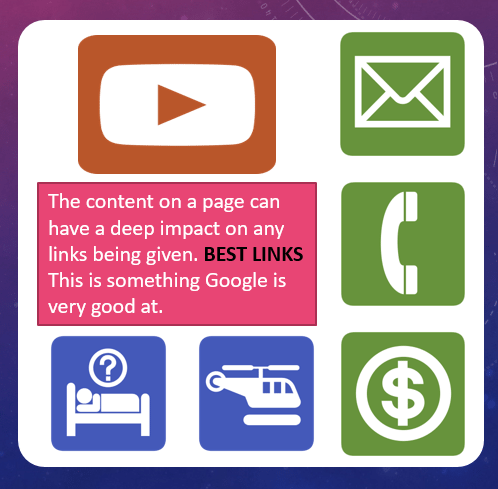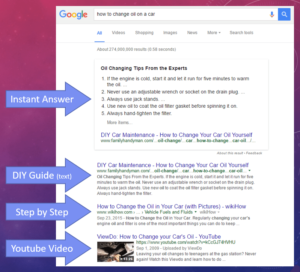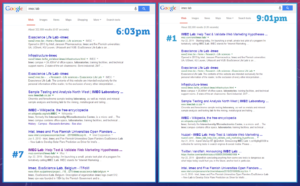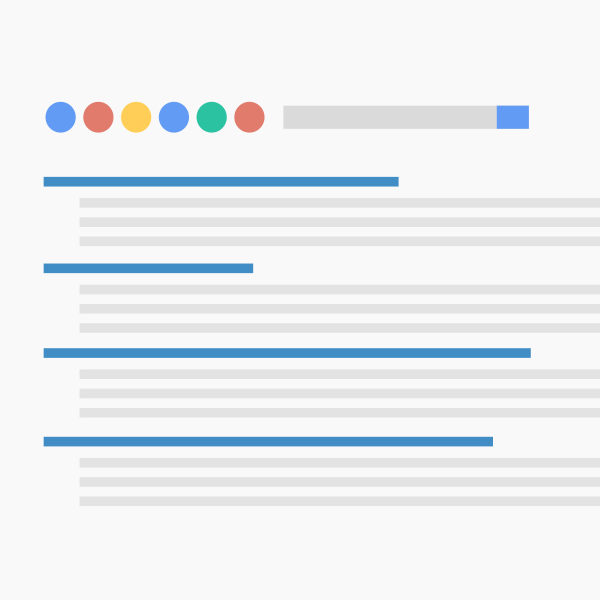When it comes to ranking on search engines (and on Google in particular), there are well over 300 factors that search engines use to judge your site and decide how it should rank. Unfortunately, this isn’t a stagnant list; it is a dynamic and fluid part of Google’s ranking algorithm. Since Google makes over 400 core changes to its algorithm per year, it can be impossible to keep up with updates without becoming discouraged. The intent of this article is to compile some of the most impactful factors and help you narrow your focus for your business and website.
There are three fundamental pillars of website rankings. Those pillars are as follows:
- Links
- Content
- The RankBrain algorithm (as confirmed by Senior Search Analyst Andrey Lipattsev in a Google Q&A session)
These pillars break down into hundreds of factors that Google uses to index and judge a page. Below, we discuss the most important factors as they relate to the three core ranking factors.
Links
The important link factors include link authority, link context, and link format. Each of these factors is discussed at length in the following sections.
Link Authority or Trust
 One of the most common and important ranking factors is a link’s authority. However, instead of ‘authority’, would encourage the adoption of a different term that describes the factor more accurately: Trust. The trust of a page sheds light on whether a link is valuable or not. Trust is much harder to manipulate, will likely play a bigger role in rankings as the algorithms evolve. When evaluating ‘trust’, search engines may not necessarily look at things like PageRank or Domain/Page Authority but rather the relevance and publishing authority of a given source. The more that experts link to your site, the better your content will be associated with a related search.
One of the most common and important ranking factors is a link’s authority. However, instead of ‘authority’, would encourage the adoption of a different term that describes the factor more accurately: Trust. The trust of a page sheds light on whether a link is valuable or not. Trust is much harder to manipulate, will likely play a bigger role in rankings as the algorithms evolve. When evaluating ‘trust’, search engines may not necessarily look at things like PageRank or Domain/Page Authority but rather the relevance and publishing authority of a given source. The more that experts link to your site, the better your content will be associated with a related search.
Link Context
 Link context is a newer player in the ranking algorithm, and it arises from evaluating the ‘context’ of a link—i.e. the content surrounding it—and judging its purpose. Link context includes such things as link placement, link relevance, and link type (i.e. whether a link is natural, editorial, or sponsored). What this means is that you should make sure links to your website have a purpose; whether it is a citation, reference, or identification, there should always be a reason for a link to an external site besides simply an attempt to improve ranking.
Link context is a newer player in the ranking algorithm, and it arises from evaluating the ‘context’ of a link—i.e. the content surrounding it—and judging its purpose. Link context includes such things as link placement, link relevance, and link type (i.e. whether a link is natural, editorial, or sponsored). What this means is that you should make sure links to your website have a purpose; whether it is a citation, reference, or identification, there should always be a reason for a link to an external site besides simply an attempt to improve ranking.
For example, techniques such as blog commenting and forum posting are considered obsolete within the industry; however, that belief is simply untrue. If the context of the comment or post has purpose and makes sense, then such activities are completely acceptable. This illustrates how crucial context is for any given link.
Link Format
Using appropriate anchor text is not a new concept, and neither is making sure your links are ‘followed’. However, the overall structure, abundance, and portfolio of links is important when it comes to ranking on Google. Google want to see a natural array of link formats, which indicates the links are organic and not the result of gamesmanship. It is fine to have links anchored to money terms, assuming they adhere to the factors listed above. However, it is imperative to have a diverse and healthy link portfolio. It is natural to get no-follow links and even brand or URL mentions instead of money terms. When we consider how links naturally occur, it is clear that the anchor text would rarely include a valuable keyword; rather, it is more likely to be the name of business, the URL, or even the word ‘website’. This is why having an assorted variety of link types and anchor text is so valuable.

Content
The important content factors include such things as content relevance, content usability, and user task completion, all of which we explain in the sections below.
Content Relevance
Content relevance is another factor that shouldn’t be new to anyone. The need for relevant content has always been a requirement to rank well. The specific thing I want to call out here is the need for content to fit the query a user performs. For instance, if users search for cats, they want to see information on cats, and if they search for dentists, they clearly want to find dentists. Understanding the intent of a given search is the key to creating relevant content.
Even subtle differences like pluralizing a search term can mean the difference between being relevant to a query and not. Let’s take the example of a search for ‘Plumbers Baytown TX’ and another search for ‘Plumber in Baytown TX’. As you can see from the results below, pluralizing the search returns more ‘directory/list’ type sites, whereas a non-pluralized search returns links to individual businesses. It is thus critical to take relevance into account when creating page content.

Content Usability
The usefulness of your webpage and its content has become a much more important ranking factor. Usability is not just about the actual text on a page, but it also has to do with your site’s user interface. Is it appealing to the eyes? Is it easy to navigate? Can the user quickly find the information he or she wants? Those factors profoundly affect the overall usability of a site.
Below, I took the example of ‘how to clean a small fish tank’ and took a snapshot of the first result, the 54th result, and the 99th result. Usability becomes a very apparent factor when we compare each page. The first result offers terrific usability, with pictures and sub-categories for the entire process. The 54th result has less than a paragraph about cleaning a fish tank, and the 99th result had nothing but a relevant title.

User Task Completion
The last important content factor is user task completion, which is a combination of usability and relevance. Content must match the end goal or need of a user. As in the previous example, if we want to ‘learn how to clean a fish tank’, the content must address how someone can ‘learn (textually, visually, etc.) how to clean a fish tank’. The same is true for any query. A clear example of this is ‘how to change the oil in a car’. If you look at the results for such a search, you see that Google is clearly trying to provide the best answer without you having to dig further. Furthermore, they provide a DIY guide, a wikihow guide with pictures, and even a video result, to give you multiple choices depending on how you want to learn. Always keep the users intent and end goal in mind, not just for the content, but also for keywords and links.

RankBrain
RankBrain is the technical term for the Hummingbird algorithm change that occurred in 2013, involving improved understanding of content meaning. RankBrain factors include deep/machine learning, social signals, user signals, and brand signals.
Deep/Machine Learning
The ability to understand text and conversation has been a huge goal for Google any many experts within the Artificial Intelligence field. The intent is to discover relationships between the meaning of words and the way they relate to each other, as well as how they relate to other entities. This deep understanding will not only help search engines understand a user’s needs, but also what they are looking to accomplish. This desire to understand relationships is what drove the Knowledge Graph project and eventually led to some amazing correlations that occur when you do searches. This will continue to grow and be an ever more important step in the evolution of search.
Social Signals
The aggregation of user interactions is the next important RankBrain factor. For instance, if someone likes a post or thumbs down a comment there is a very clear like or dislike correlation between that user and that piece of content. This data on a mass scale can help search engines judge and weigh the ‘naturalness’ of a website and its content. If something goes viral, the spread is usually through social channels; therefore, an explosion of links makes sense. However, if the explosion of links occurs without this social spread, search engines may see it as unnatural or irregular and might devalue or penalize the site in terms of rank. This connection and judgment can be seen in long-tail search results, such as when I search for ‘guy who makes an expensive sandwich’, and Google knows exactly whom I meant. It returns the most popular sites on social media first and then goes down from there.
User Signals
Right in line with social signals, Google can also evaluate user behavior. Through its connections with Android, Nexus, and Chrome, Google has a lot of in-depth user data at its disposal, not to mention all of the analytical data it can gather on the back end. This includes the stuff you see in Search Console or Analytics, such as how long users stay on your site, what they do while they are there, and even who else they visited. User interaction is starting to play a much larger role in the real-time search algorithm. ‘Click’ testing experiments done by Rand Fishkin reveal that there is a strange correlation between SERPs and how users interact with them.

Brand Signals
Lastly, branding has become a burdensome—but necessary—factor in Google ranking. This doesn’t mean you have to have a multi-million dollar corporation to see results in Google, but rather that you need to become (as best you can) synonymous with your industry, your audience, and what your audience seeks.
For instance, if I say ‘shoes’, what brands come right to mind. For me, it is Nike, DC Shoes, Adidas, Vans, Puma, and so on. Google tries to help companies that become the ‘source’ for products or concepts. Google has even been known to give preferential treatment to brands for certain keyword-esque searches. When we search ‘basketball shoes for men’ Google returns the best shopping results, which reveals a clear brand trend of Nike, Under Armour, Adidas, and Champion. We get similar brand recognition from a more generic search like ‘cell phone’, in which Apple and Samsung get primary brand preference.

Links, Content, and RankBrain!
If you can remember the three pillars of search and then gear your website and business toward users, you shouldn’t have any problem ranking in Google. It may take time to get certain elements into place, but SEO is a long-term investment. If done right, it will continually return the effort you put into it.
Do you agree with my list? Have your own perspective? Let me know in the comments!

